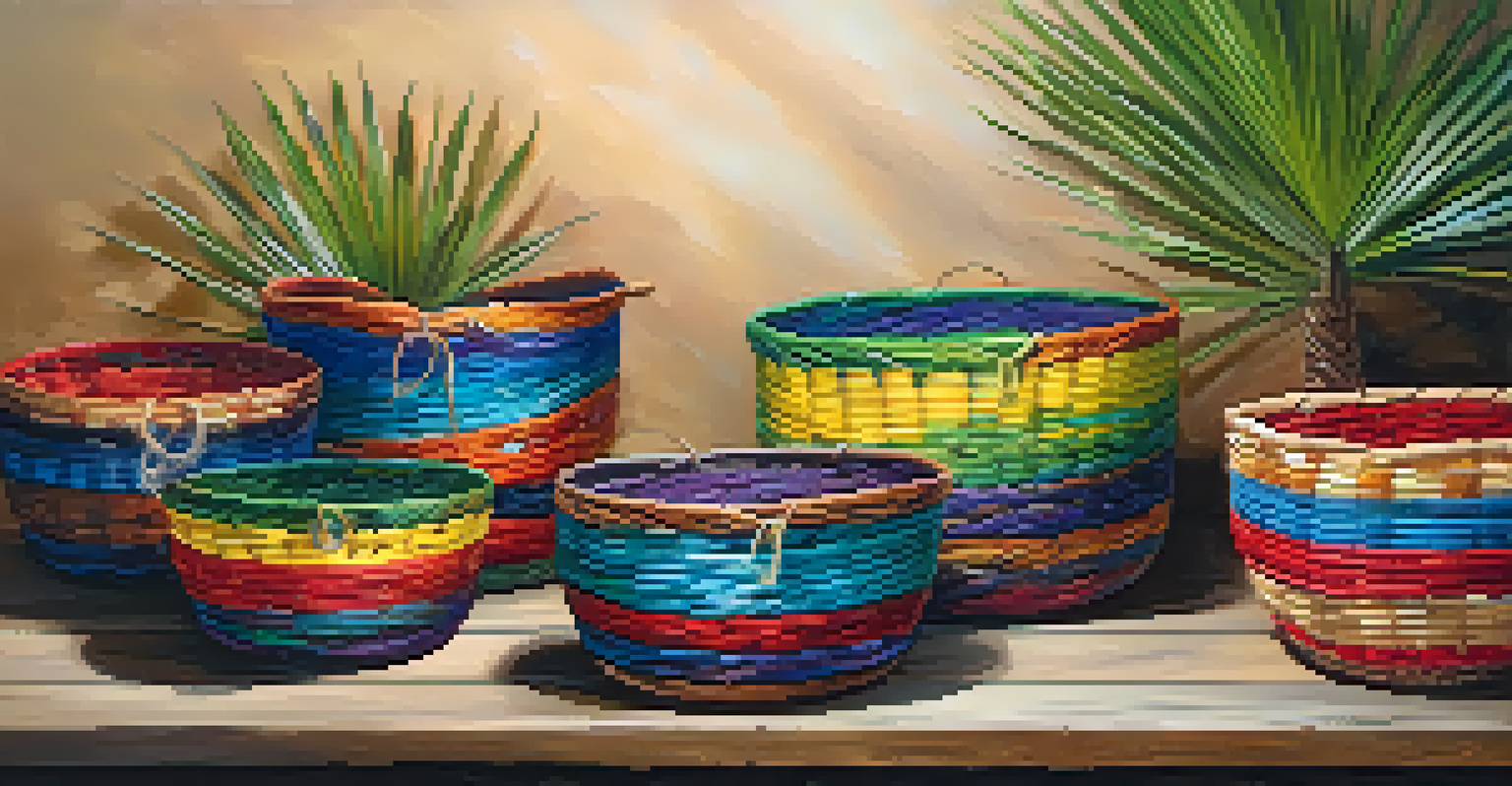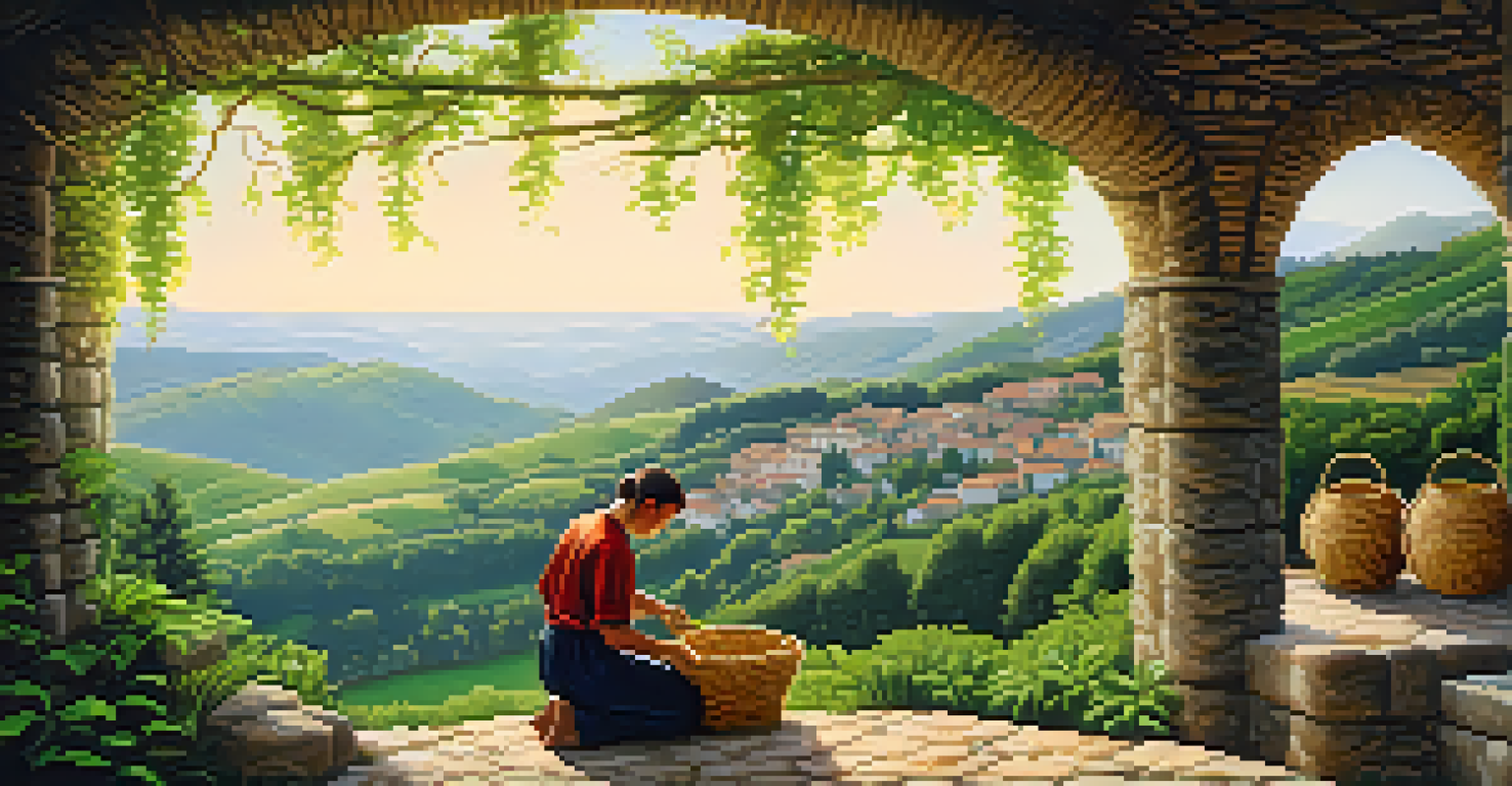Traditional Spanish Basket Weaving: Techniques and Styles

The Rich History Behind Spanish Basket Weaving
Basket weaving in Spain has deep roots, tracing back to ancient times. Communities relied on this craft for practical uses, creating functional items for daily life. Over generations, these techniques evolved, becoming not just a necessity but an art form.
Art is the most beautiful of all lies.
Different regions in Spain developed their own unique styles, reflecting local materials and cultural influences. For instance, the Canary Islands are famed for their intricate palm frond baskets, while the Basque Country showcases beautifully woven willow creations. Each region's baskets tell a story of its people and traditions.
Today, this traditional craft continues to thrive, with artisans dedicated to preserving these age-old techniques. By weaving together history and culture, Spanish basket weaving remains a vibrant part of the country’s heritage.
Materials Used in Traditional Basket Weaving
The choice of materials in Spanish basket weaving is crucial, as it defines both the look and durability of the final product. Common materials include reeds, willow, and palm fronds, each offering unique textures and flexibility for weaving. These natural resources are often sourced locally, connecting the craft to the land.

For instance, the use of esparto grass is prevalent in many regions, known for its strength and durability. Craftsmen appreciate its versatility, allowing for both simple and complex designs. This connection to natural materials not only enhances the aesthetic but also promotes sustainability.
Rich Heritage of Basket Weaving
Basket weaving in Spain is a centuries-old craft that reflects local cultures and traditions across various regions.
Another popular material is wicker, which is often used for making furniture and decorative items. Wicker baskets can range from functional storage solutions to intricate decorative pieces, showcasing the diversity of Spanish weaving traditions.
Techniques of Traditional Basket Weaving
Spanish basket weaving techniques can vary significantly from one region to another, yet some fundamental methods are widely used. The most common technique involves interlacing strands of material to create a sturdy structure. This weaving process requires skill and patience, with artisans often spending hours perfecting their craft.
Crafting is an opportunity to create something from nothing, to bring beauty into the world.
One notable technique is the 'cesta' style, which uses a spiral method to build up the walls of the basket. This approach not only provides strength but also adds a unique visual pattern. The beauty of this style lies in its simplicity, allowing the natural materials to shine.
Another technique worth mentioning is coiling, where a long, flexible material is wound around itself to form the basket's shape. This method allows for more intricate designs and is often used in creating decorative pieces that showcase the artisan’s creativity.
Distinct Styles of Spanish Baskets
In Spain, each region boasts its distinct basket weaving style, shaped by local culture and available materials. For example, the 'cesta de mimbre' from the Basque Country is renowned for its sleek, elegant lines and functional designs. These baskets often reflect the maritime heritage of the region, incorporating elements that resonate with the sea.
Conversely, the 'cestas de esparto' from Andalusia are known for their rustic charm and robust construction. These baskets are typically used for agricultural purposes, showcasing a more utilitarian approach to weaving. The earthy tones of esparto grass give these pieces a grounded, authentic feel.
Unique Materials and Techniques
Artisans use diverse materials like esparto grass and palm fronds, employing techniques such as interlacing and coiling to create both functional and decorative baskets.
Additionally, the Canary Islands feature beautifully vibrant baskets made from palm fronds, often adorned with colorful threads. These pieces are not only practical but also serve as stunning decorative items, highlighting the island's rich artistic traditions.
Cultural Significance of Basket Weaving
Basket weaving in Spain is more than a craft; it's a cultural expression that has been passed down through generations. Many families have been weaving baskets for centuries, making it a significant tradition within their communities. This craft often brings people together, fostering a sense of belonging and shared heritage.
Moreover, traditional basket weaving plays a vital role in local economies, especially in rural areas. Artisans often rely on their skills to support their families, and festivals celebrating this craft attract tourists, helping to sustain the tradition. These gatherings showcase the beauty of the craft and provide a platform for artisans to share their stories.
Through workshops and exhibitions, younger generations are learning these techniques, ensuring that the art of basket weaving continues to thrive. This cultural transmission is essential for keeping the tradition alive and relevant in today's world.
Modern Adaptations of Traditional Techniques
While traditional basket weaving techniques are still cherished, many artisans are embracing modern adaptations to appeal to contemporary tastes. By experimenting with colors, patterns, and even new materials, they are breathing new life into this ancient craft. This blend of tradition and innovation keeps the art relevant in today's market.
For instance, some artisans combine traditional weaving techniques with modern design trends, creating items that are both functional and stylish. This approach has led to a resurgence of interest in woven products, particularly among younger consumers looking for unique home decor.
Support for Local Artisans
Purchasing handmade baskets and participating in workshops can help sustain the traditional art of basket weaving and support local economies.
Additionally, collaborations with designers and artists have opened up new avenues for basket weaving, expanding its reach beyond mere functionality. These modern adaptations highlight the versatility of the craft, ensuring that it continues to captivate audiences worldwide.
How to Support Traditional Basket Weaving
Supporting traditional Spanish basket weaving is easier than you might think! One of the best ways is to purchase handmade baskets directly from artisans or local markets. By choosing authentic pieces, you're not only acquiring beautiful items but also supporting the livelihoods of skilled craftspeople.
You can also promote awareness by sharing your love for these crafts on social media or through word of mouth. Highlighting the stories behind the baskets and the artisans who create them helps keep the tradition alive. Every share counts towards fostering appreciation for this rich cultural heritage.

Lastly, consider participating in workshops or events that focus on basket weaving. These experiences offer hands-on learning opportunities while connecting you with the craft's history and community. Engaging with traditional techniques helps ensure they are passed down to future generations.